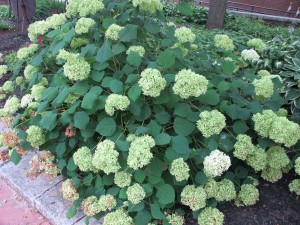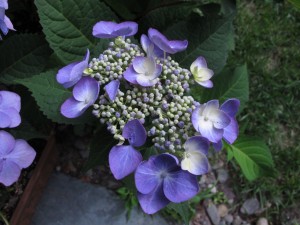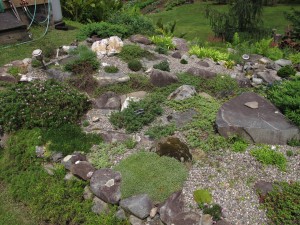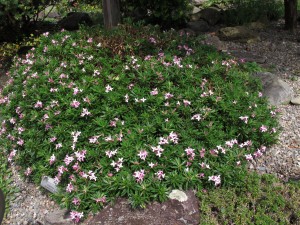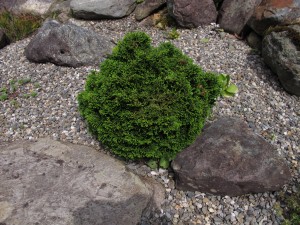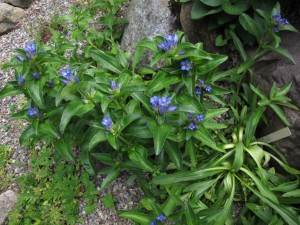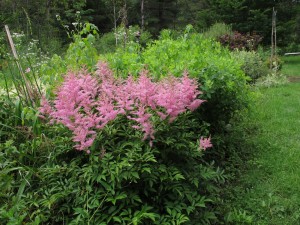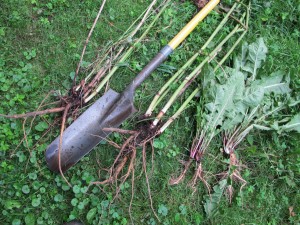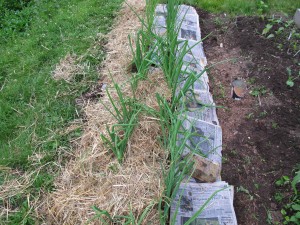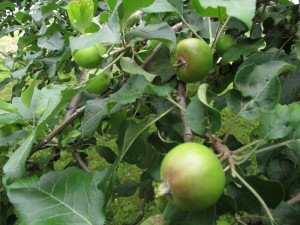Hydrangeas
Although I think of August as the month for hydrangeas, there are many kinds and some have been blooming for weeks while others are still in bud. Coming on now for me is the PeeGee (from the scientific name, Hydrangea paniculata grandifolia). I’ve had one for 20 years or so, and I love it.
Like all mid-and late-summer bloomers, PeeGee hydrangeas bloom on “new wood” – this year’s growth. Mine sends out perhaps a hundred 2 to 3-foot long stems, each with a big white panicle made up of hundreds of little flowers. Over time, the white changes to pink on many, and frost turns the panicles brown.
The flowers clusters on my PeeGee hydrangea are so big that their pencil-thick stems often cannot hold them up when they’re in full bloom. The flowers bend down the stems, particularly after a rain. Some years I snip off the tips of the panicles with pruning shears before they get to full size. This lessens the weight and the stems do not bend so much. The shrub is 8-10 feet tall and wide.
In one sense, the PeeGee hydrangeas are like daylilies: they will bloom every year, no matter what. They do best in full sun, but put will still on a good show in part shade. It prefers rich, moist, well drained soil – but will grow anywhere.
Another variety of hydrangea is the ‘Tardiva’ type. The flower panicles contain fewer florets and are a mix of fertile and infertile blossoms. The infertile ones have wider petals, and help to attract pollinators with their looks. The panicles are longer and more tapered than PeeGee hydrangeas, and rarely flop, even when wet. I have a cultivar named ‘Pink Diamond’ that I just love. It fades to a light pink. ‘Pinky Winky’ is another nice one that develops a deeper pink color.
The smooth hydrangea (H. arborescens) is another popular hydrangea, and one that will bloom well in shade. I particularly like ‘Snow Hill,’ which flowers well even in deep shade, and which produces nice small to medium-sized panicles that rarely flop. More popular, however, is ‘Annabelle’ because it produces huge flower panicles. But this variety always flops, especially after a rain, and I think they look as messy as an unmade bed. Annabelle is often used in perennial beds, even in full sun. In full sun it may require regular watering. The flowers start green, then go to white, and finally to brown, putting on a nice show for 6-8 weeks. The smooth hydrangea can be cut to the ground each fall or early winter and allowed to start anew each spring. I cut back ‘Snow Hill’ each fall, but do not cut it to the ground.
For those of us in cold climates, the blue or pink hydrangeas are best considered as annuals. Yes, many will survive a Zone 4 winter, but most times they will not produce many flowers after the first year. They are called bigleaf hydrangeas (H. macrophylla) for their handsome foliage, but we buy them for the color.
Bigleaf hydrangeas need very acidic soil (pH of 5.0 to 5.8) to have blue flowers, and a pH of 6.0 to 6.5 to be pink. On planting, you can add soil acidifier to get the blue color or limestone to get pink. Most blue ones come with some acidifier –usually sulfur- in the soil, but it goes away after a while.
Several years ago there was a huge fuss made over a variety of bigleaf hydrangea called ‘Endless Summer’ that was promised to thrive in Zone 4 (despite winters of minus 30 degrees). I often refer to it as ‘Endless Disappointment’ as I have tried it twice, and after Year #1 have only gotten a few blossoms very late in the summer.
This year I was given a nice blue one called ‘Twist and Shout’ At the website, it noted that it is a hybrid developed by Michael Dirr, one of America’s most noted horticulturists, and the author of the book I depend on to learn about trees and shrubs: Manual of Woody Landscape Plants: Their Identification, Ornamental Characteristics, Propagation and Uses.
I have my Twist and Shout in a large self watering container by the front door, but now that I know it was developed by Professor Dirr, I shall acidify a spot in full sun and plant it in the ground in the fall. The website says it is a re-bloomer, so does not just bloom on buds set the summer before, but on new wood, too.
Another great hydrangea that I grow is the climbing hydrangea (H. anomala subspecies petiolaris). It can take up to six years for a small plant to get established and start growing, but then it takes off and grows like mad. It is a vine that will thrive in shade, though it also can grow in sun, if provided adequate moisture. The north or east side of a building is perfect. It easily attaches to brick, stone or trees, but needs help to grow on a wood building. Mine sends flower shoots out horizontally and can support its handsome flowers without flopping 3 feet or more from the barn.
Henry Homeyer can be reached at P.O. Box 364, Cornish Flat, NH 03746 or at henry.homeyer@comcast.net. He is the author of 4 gardening books, and a children’s fantasy-adventure about a boy and a cougar called Wobar and the Quest for the Magic Calumet.
Rock Gardens
Many plants that do well in rock gardens originally come from places with extreme growing conditions such as deserts or the rocky slopes of mountains. Most have tight foliage, low profiles and deep tap roots to keep from blowing away when the wind blows. But generally in those difficult locations, pollinators are few and far between. In order to attract them, these plants favor big flowers (in relation to the size of the plants), bright colors and strong scents. “Hey, it’s me! Come visit!” they seem to be saying with their floral displays. And those flowers also attract gardeners who are willing to tend them, pull weeds and build soils to their particular needs.
I recently visited Lisa Palmer and Dan Drew in Plainfield, NH where they have a splendid rock garden. In fact, Lisa is so avid a rock gardener that she was one of just 5 Americans who attended the Second International Rock Garden Society’s meetings in Czech Republic this May.
I asked Lisa what is critical for success with a rock garden. Without pausing to think, she said, “Perfect drainage.” Rich soil and lots of compost? Save it for the veggies. Good rock gardens are made with sandy soil and very little organic matter.
Seventeen years ago Lisa and Dan started a rock garden after they had an artesian well drilled which provided them with plenty of sand and ground rock. Dan enjoys hard physical labor, so he agreed to dig out the existing soil in the area where the rock garden was planned and spread the sandy, gravelly mess.
Dan dug out 18 inches of soil, replacing it with coarse sand and gravel. He also moved some good –sized river stones up to the garden, which gave it some “bones” to work with. Their subsoil was well drained and somewhat sandy, which was good for a rock garden. Lisa explained that you must work with what you have. If you have a heavy clay soil and live in a low place, you can’t easily create a rock garden.
Many of the plants in the rock garden of Dan and Lisa are related to plants I know, but not species I can grow in my rich garden soil. They have a number of kinds of daphne including rose daphne (Dapne cneorum) and a lovely hybrid in bloom right now, Daphne x schlyteri. This is an evergreen daphne that grows to just 8 to 12 inches tall and roughly twice as wide – much smaller than the daphne I grow. The leaves are narrow and dark green; they grow out from each stem like spokes on a series of increasingly large wheels. The flowers are small, pink and highly fragrant.
Dwarf conifers are the backbone of many rock gardens as they are slow growing and are as beautiful in winter as they are in summer – and perhaps more so, as they contrast nicely against the snow. One that Lisa and Dan use effectively is hinoki cypress, also called hinoki falsecypress (Chamaecyparis obtusa ‘Nana’).Whenever you see “Nana” in a scientific name ti means that the plant stays small – just like my grandmother, who we called Nana.
Hinoki cypress reminds me of a something from the sea, perhaps a type of coral or seaweed. Its dark green foliage forms twisting fan-shaped little branches in dense tiered layers. It is hardy to Zone 4 – if it has the proper growing conditions: moist, well drained soil. It can grow to a foot or two tall and up to three feet wide. I’ve tried growing it without success – I somehow can’t plant something and not give it compost.
Gentians are good rock garden plants. I grow a nice fall blooming gentian, one called Gentiana makinoi ‘Marsha’ which blooms in ordinary garden soil with sky-blue flowers in September. Blooming now in their rock garden is one called star gentian (Gentiana cruciata.) In the spring they have others called Gentiana acaulis and Gentiana vern – plants that Lisa consider the gems of the genus. Both have wonderful blue flowers.
Cactus does well in rock gardens, some surviving in Zone 4 (with winter temperatures dropping to minus 30 degrees F on occasion). Prickly pear cactus (Opuntia spp.) grows well for Lisa and Dan, spreading to form small colonies. Sedums and hens and chicks also do well.
Lewisia is another genus of rock garden plant they like. Originally observed in 1806 by Meriwether Lewis of the Lewis and Clark Expedition, it needs very fast drainage to avoid rotting the root (which is edible, though since the common name of Lewisia is “bitterroot”, it is not likely to grace my table). The rosette –shaped flowers come in a variety of cheerful colors.
Maintaining a rock garden is a labor of love. Common weeds can choke out or overcome some rock garden plants unless you keep after them. Dan told me that he mulches most areas with pea stone (3/8 inch smooth gravel). It gets very hot in summer, effectively burning off young weeds. Still, I’m not ready to commit to creating and maintaining a rock garden. Well maybe … after I retire.
Henry Homeyer is a gardening consultant, public speaker and the author of 4 gardening books. His web site is www.Gardening-Guy.com. He lives in Cornish Flat, NH.
Rainy Day Woes
It’s been rainy here in Cornish Flat. I can’t remember whether the recent bout of rain was 10 inches in 7 days or 7 inches in 10 days. But I do know that my old leather clogs appear to have grown a layer of mold that looked like the stuff that grows on phlox and lilacs, powdery mildew. Sigh. My tomatoes want some sunshine – and I do, too.
But all this rain is not all bad. Let me sing praises to the rain: First, we don’t have to water anything. Usually I have to water my vegetable transplants and seed beds. Not this year.
I like raised beds for everything but onions and celeriac (also called celery root, a wonderful substitute for celery in cooking). Those two plants need lots of water, so I usually do not plant them in raised beds because raised beds drain better and dry out quicker- which they don’t like. But when my stream overflowed, my onions suffered from the running water that ran through my garden while most other things were not affected. No matter, I just righted them and re-mulched around them.
Newly planted trees and shrubs are doing well with all this rain, too. They need an inch of water a week, and that has not been a problem this year. And I always have plants in pots waiting to go in the ground which normally have to be watered. I have a pink magnolia that I bought over a month ago that is still waiting to get planted – and I have only had to water it once.
That magnolia is a hybrid called ‘Jane’, one of eight varieties developed by the USDA in the 1950’s. I’m surprised it’s not more common in cold areas, as it is gorgeous, hardy to Zone 3 (minus 40) and has the added benefit of sporadic re-blooms in August. It is a small to medium sized tree. Others in the series include Betty, Judy and Ann and others often referred to as “the magnolia girls”. All bloom 2-4 weeks later than the early star magnolia, thus usually avoiding frost damage. I can’t wait!
On the other hand, all this rain has been heaven for slugs and snails. They like wet surfaces, and that’s about all we’ve had. What can we do about them? I always start by hand picking. My kale has suffered the most. Lower leaves have been very heavily grazed by small snails. I have gone around with a jar of soapy water, tapping the leaves to make the snails drop into the water. I also have pruned off some of the lower leaves – they were Swiss cheese-like and not contributing much to the plants.
Snails and slugs tend to avoid sharp surfaces, so sprinkling coarse sand on the soil surface should help discourage them, though it is hard to know the effect. I mean I can’t exactly interview them. (Mr. Slug, how do you feel about crawling over sand to get to the kale?”)
Slugs can be controlled with a product approved for organic gardeners. It’s called Sluggo and is iron phosphate (a naturally occurring mineral) covered with slug bait. I use it around the logs that I inoculated with spore plugs to produce Shitake mushrooms. I haven’t gotten any mushrooms yet this year – they bloom best in hot weather following a wet period. A small amount of Sluggo goes a long way and ends up being cheaper than the traditional method of putting out saucers of beer to attract and drown slugs. Which I find disgusting, anyway. I never have to deal with the slugs done in by Sluggo.
I haven’t yet done much mulching this year so there is lots of bare earth in my vegetable garden. Although that means that weeds get a “Get out of Jail Free” card, it also means that the soil dries out more quickly, which is a good thing. I use my CobraHead weeder to scratch the soil surface after rains to slice off any young weeds, but more importantly, to rough up the soil surface. A rough surface allows water to evaporate more quickly. And we need that.
The last good thing about all this rain is that big-rooted weeds pull more easily. The key is to pull them slooooowly. Gentle pressure. And if they don’t move, loosen the soil with a drain spade and try again.
So far this summer I haven’t gotten powdery mildew, that bothersome white fungus that so loves old fashioned phlox and lilacs. By August, I suppose it will be rampant. Hot wet weather makes plants more susceptible to it.
You can do something now, if you’ve had trouble with powdery mildew in past years: you can divide big clumps of phlox and other mold-prone plants. That way you will have better air circulation, allowing leaves to dry out before mold hyphae (rootlets) can penetrate the moist leaves. Even mildew-resistant cultivars will get moldy if the conditions are right.
So yes, I’m ready for sunny days. But rain does have plenty of good qualities. Let’s all try to appreciate it for the nectar it is for our plants.
Henry Homeyer can be reached at henry.homeyer@comcast.net. His Web site is www.Gardening-Guy.com.
Eight Flowers Great Flowers
“I have a brown thumb” is a claim I hear on a regular basis, but one which I always dispute. There are no brown thumbs, only bad soil or plants living (and dying) where they should not be. Of course, any plant can die of thirst when first planted, and poor soils can keep them from thriving. But some plants are tougher than others, so this week I shall suggest eight plants that you can use in your garden with a very high probability that they will do well for you. Even very well. Even if you have a brown thumb. Just put them in good soil in the right amount of sun.
Daylilies (Hemerocallis spp.) are fool proof. I once left a clump of daylilies on the lawn in a relatively shady place. I had dug them up and fully intended to put them in the compost pile, but didn’t get around it right away. Before I knew it, they had rooted in – and were blooming!
Daylilies prefer full sun and good soil, but they’re not fussy. The old orange ones spread by root, as do the double orange ones. Most others just develop into bigger clumps every year. Daylilies produce flower stalks called scapes, and each scape will produce 3 to 9 buds; these buds bloom sequentially, each for just about a day – hence the name. Most daylilies come in shades of yellow, but dark reds and some pinky ones exist, too. A few re-bloom off and on all summer.
Evening primroses or sundrops (Oenothera missouriensis) are blooming for me right now, but they are not really primroses at all. The flowers are bright yellow cups on 18 to 30-inch stems that flower – and spread – cheerfully. They spread by root and by seed, and might be thought to be thugs, except they pull easily and are pleasant. They will bloom in full sun to part shade, and are not fussy about their soil.
Peonies (Paeonia spp.) These beauties are mostly done for the season, though a few late bloomers might still be blooming. They love full sun and rich soil, but will still bloom in part shade and even in dry, sandy soils. Their roots are big, fleshy tubers that go deep down into the soil, so I recommend digging a much bigger and deeper hole for a peony than for other plants. Enrich the soil with composted cow manure, rotted leaf mulch or other organic products, especially some organic fertilizer.
Peonies grow from buds or “eyes” that develop each year beneath the soil surface. If you plant a peony too deeply and cover up the eyes with more than an inch of soil, the plant will not bloom after the first year. Other than that? Success is guaranteed. I have a peony that my grandmother Lenat planted – and she died around 1953. My mother grew it, now I have it. I shall leave it to one of my grandchildren. Peonies are forever.
Pink Mallow (Malva alcea). Some fancy gardeners turn their noses up at pink mallow, but I love it. It grows 3-5 feet tall and produces a bounty of pink blossoms that vaguely resemble single roses- but up to 3 inches in diameter. It has a deep tap root so it does not move easily, but seed-grown “volunteers” show up around my garden. Full sun to part shade. It is a short-lived perennial, but has plenty of “babies” so you will always have some.
Black-eyed Susans (Rudbekia spp.) There are dozens of species of this joyful summer flower. I grow a variety called ‘Prairie Sun’ in my hot, dry front walkway, and it blooms all summer – but, truth-be-told, often die in winter. No matter, I’ll buy it again and again. One of my favorites is a fall-season bloomer with delicate flowers, Rudbekia subtomentosa ‘Henry Eilers’.
Hostas (Hosta spp.). These are primarily shade plants grown for their lovely leaves. If there is too much sun on them, the leaves will scorch and turn yellow. A few kinds will bloom with tall flower spikes, but others have blossoms that are not of much interest. Hostas do best with rich soil, but will grow in almost any soil. I have hostas from under 2 inches tall to more than 30 inches tall, and a variety of greens, some with blue or yellow tinges.
Astillbes (Astillbe spp.). These are primarily sold as shade plants, but I grow them in both full sun and partial shade. The key is this: the more sun there is, the more moisture is needed. They bloom in great plumes of tiny florets in pink, white and dark red. They appreciate rich, organic soil, so improve the soil before planting.
Bee Balm (Monarda didyma). Bee Balm displays nice clumps of red or pinkish tubular flowers that are arranged in whorls atop 3-4 foot stems. In the mint family, they are fragrant and clumps spread by root – sometimes too vigorously. But extra plants are easily pulled. Grow them in morning sun in ordinary garden soil. All day sun in dry, sandy locations will not lead to happy plants.
You don’t have to be born a gardener. Just follow the directions on the plant tags – or my articles – and be sure to add compost to the soil before planting in a nice, big hole. You’ll soon have a green thumb.
Henry Homeyer can be reached at P.O. Box 364, Cornish Flat, NH 03746 or henry.homeyer@comcast.net. His Web site is www.Gardening-guy.com.



